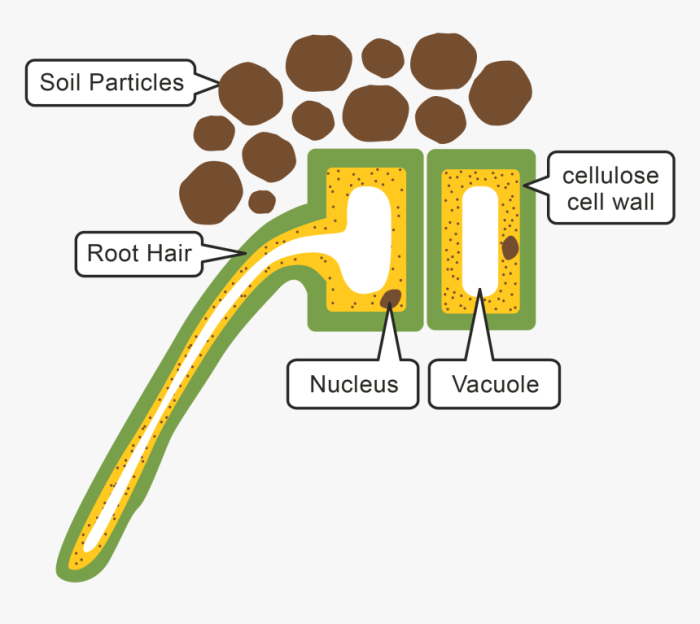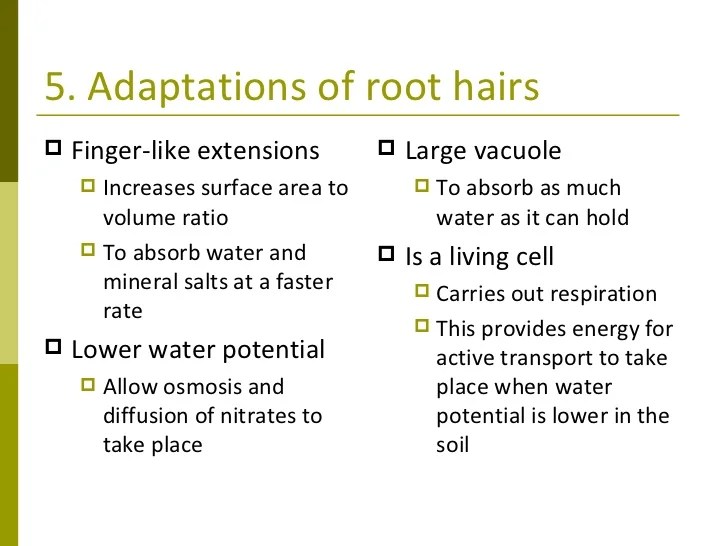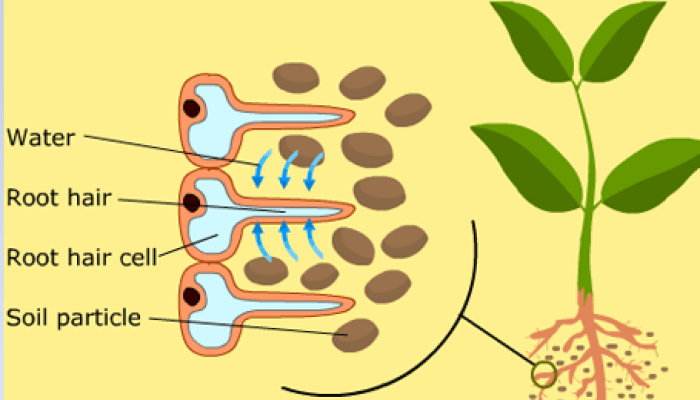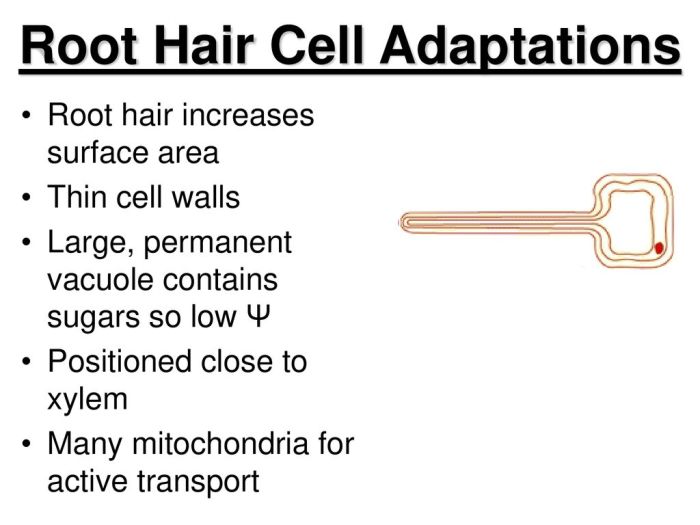Adaptations of a root hair cell – Adaptations of root hair cells, the microscopic marvels responsible for nutrient and water absorption in plants, unveil a captivating narrative of biological ingenuity. This exploration delves into the intricate structure, development, and adaptations of these remarkable cells, shedding light on their vital role in plant survival and ecosystem health.
The structure of root hair cells is meticulously designed for their specialized function. Their elongated, hair-like projections vastly increase the surface area available for absorption, while their thin cell walls facilitate the efficient movement of water and nutrients into the plant.
These cells are further equipped with specialized transport proteins that selectively uptake essential elements from the soil.
Root Hair Cell Structure

Root hair cells are specialized cells found in the roots of plants that are responsible for absorbing water and nutrients from the soil. They are long, thin cells that extend from the surface of the root into the soil.
The structure of the root hair cell is well-suited to its function. The cell wall is thin and flexible, allowing the cell to elongate and penetrate the soil. The cell membrane is semipermeable, allowing water and nutrients to pass through while keeping out harmful substances.
Organelles
The root hair cell contains several organelles that are essential for its function. These organelles include:
- Vacuole:The vacuole is a large, central organelle that stores water and nutrients. The vacuole helps to maintain the cell’s turgor pressure, which is essential for the cell to absorb water and nutrients.
- Mitochondria:Mitochondria are organelles that produce energy for the cell. The energy produced by mitochondria is used to power the cell’s metabolic processes, including the absorption of water and nutrients.
- Endoplasmic reticulum:The endoplasmic reticulum is a network of membranes that folds and transports proteins. The endoplasmic reticulum helps to synthesize and secrete the proteins that are needed for the cell to absorb water and nutrients.
- Golgi apparatus:The Golgi apparatus is a stack of membranes that modifies and packages proteins. The Golgi apparatus helps to prepare the proteins that are needed for the cell to absorb water and nutrients for secretion.
The structure of the root hair cell is perfectly adapted to its function of absorbing water and nutrients from the soil. The thin cell wall, semipermeable cell membrane, and specialized organelles all work together to allow the cell to take in the water and nutrients that the plant needs to survive.
Root Hair Cell Development

Root hair cell development is a complex process that begins with the formation of a root hair primordium. The primordium is a small, bulge-like structure that forms on the surface of a root cell. The primordium then elongates and forms a tube-like structure called a root hair.
The root hair cell is a specialized cell that is responsible for absorbing water and nutrients from the soil.
Factors Influencing Root Hair Cell Development
Several factors influence root hair cell development, including soil conditions and plant hormones. Soil conditions such as pH, nutrient availability, and moisture content can affect the development of root hair cells. Plant hormones such as auxin and cytokinin can also affect root hair cell development.
Auxin promotes the development of root hair cells, while cytokinin inhibits it.
Root Hair Cell Function

Root hair cells play a crucial role in the uptake of water and nutrients by plants from the soil. They are specialized cells that extend from the surface of the root and increase the surface area for absorption.
Adaptations of a root hair cell include an extensive surface area and a thin cell wall. These adaptations enable the cell to absorb water and nutrients from the soil. To learn more about the topic of adaptations of a root hair cell, you can take an asl unit 2 comprehension test . This test will assess your understanding of the topic and provide you with feedback on your progress.
Mechanisms of Water and Nutrient Absorption
- Water absorption:Root hair cells have a thin cell wall and a large vacuole, which creates a low water potential inside the cell. Water from the soil moves into the cell by osmosis to equalize the water potential.
- Nutrient absorption:Root hair cells release protons (H+) into the soil, which lowers the pH and makes nutrients more soluble. The nutrients are then absorbed into the cell by active transport, a process that requires energy.
Adaptations to Soil Conditions
Root hair cells adapt to different soil conditions to optimize water and nutrient uptake. For example:
- Sandy soils:Root hair cells are longer and more branched in sandy soils to increase the surface area for absorption.
- Clay soils:Root hair cells are shorter and less branched in clay soils to avoid clogging.
- Acidic soils:Root hair cells release more protons into the soil to lower the pH and increase nutrient solubility.
Root Hair Cell Adaptations: Adaptations Of A Root Hair Cell
Root hair cells exhibit remarkable adaptations that enable plants to thrive in diverse environmental conditions. These adaptations enhance the plant’s ability to absorb water and nutrients, cope with stress, and optimize resource utilization.
Types of Adaptations
- Increased Surface Area:Root hairs often have a highly branched and elongated structure, significantly increasing the surface area for absorption. This adaptation maximizes contact with the soil, enhancing water and nutrient uptake.
- Specialized Proteins:Some root hair cells produce specific proteins that facilitate the transport of water and nutrients across their membranes. These proteins act as channels or carriers, improving the efficiency of absorption.
- Mycorrhizal Associations:Certain root hair cells form symbiotic relationships with fungi, known as mycorrhizae. These fungi extend the root system, increasing the absorption capacity and providing access to nutrients that would otherwise be unavailable.
Adaptation for Specific Environmental Conditions
- Drought Tolerance:Plants in arid environments often have root hairs with thick cell walls and reduced branching. This adaptation reduces water loss through evaporation, enabling the plant to survive in dry conditions.
- Salinity Tolerance:In saline soils, root hairs may accumulate salt ions in their vacuoles. This adaptation prevents the buildup of toxic salt concentrations in the cytoplasm, protecting the plant from salt stress.
- Nutrient Deficiency:Some plants develop root hairs with increased branching and length in nutrient-poor soils. This adaptation increases the surface area for nutrient absorption, enhancing the plant’s ability to obtain essential nutrients.
Specific Plant Adaptations
- Desert Plants:Desert plants, such as cacti, have root hairs with thick cell walls and a reduced number of branches. These adaptations minimize water loss and maximize nutrient absorption in the harsh desert environment.
- Mangrove Trees:Mangrove trees, which thrive in saline environments, have root hairs with salt-accumulating vacuoles. This adaptation protects the plant from salt toxicity, enabling it to survive in brackish water.
- Epiphytic Orchids:Epiphytic orchids, which grow on trees, have highly branched and elongated root hairs. This adaptation increases the surface area for nutrient absorption from the nutrient-poor bark of their host trees.
Root Hair Cell Interactions

Root hair cells play a crucial role in the overall functioning of the root system, facilitating the uptake of water and nutrients from the soil. They interact with various other cells within the root, such as root cap cells and endodermal cells, to achieve this function.
Interactions with Root Cap Cells
Root cap cells form a protective layer at the tip of the root, shielding the delicate root hair cells behind them. As the root grows and penetrates the soil, the root cap cells secrete a mucilaginous substance that lubricates the passage, allowing the root to move through the soil with less resistance.
Interactions with Endodermal Cells
Endodermal cells are specialized cells that form the innermost layer of the root cortex. They contain a waxy substance called the Casparian strip, which acts as a barrier to the passive diffusion of water and nutrients. Root hair cells interact with endodermal cells through plasmodesmata, tiny channels that allow the exchange of substances between cells.
Symbiotic Relationships with Beneficial Soil Microorganisms
Root hair cells play a vital role in forming symbiotic relationships with beneficial soil microorganisms, such as mycorrhizal fungi. These fungi form a network of hyphae that extend into the soil, increasing the surface area for water and nutrient absorption.
In return, the root hair cells provide the fungi with carbohydrates and other nutrients.
Root Hair Cell Applications

Root hair cells are not only crucial for plant growth and development, but also hold significant potential for agricultural and environmental applications. Understanding their adaptations can pave the way for advancements in crop yields, soil health, and even biotechnology.
Agricultural Applications, Adaptations of a root hair cell
In agriculture, root hair cells can be manipulated to improve crop yields. By enhancing their ability to absorb nutrients and water, plants can grow more efficiently and produce higher yields. This is particularly important in regions with poor soil conditions or limited water availability.
Environmental Applications
Root hair cells also play a role in environmental sustainability. They can be used to remediate contaminated soils by absorbing heavy metals and other pollutants. Additionally, root hair cells can help improve soil structure and water retention, reducing erosion and promoting soil health.
Biotechnology and Other Fields
Beyond agriculture and the environment, root hair cells have potential applications in biotechnology and other fields. Their unique ability to absorb and transport molecules could be harnessed for drug delivery, biosensors, and other medical and industrial applications.
Question Bank
How do root hair cells contribute to plant growth?
Root hair cells significantly enhance the surface area for water and nutrient absorption, which are essential for plant growth and development.
What factors influence root hair cell development?
Factors such as soil moisture, nutrient availability, and plant hormones play a crucial role in regulating root hair cell development and density.
How do root hair cells adapt to different soil conditions?
Root hair cells exhibit remarkable plasticity, modifying their length, density, and branching patterns to optimize absorption efficiency in various soil conditions, including drought, salinity, and nutrient deficiency.